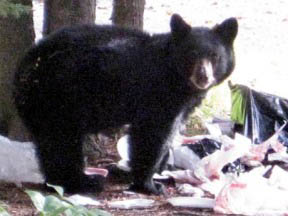
6 September 2007
Bad Time for Black Bears

This black bear that got into garbage abandoned by campers was
destroyed Tuesday morning.
Canmore Alberta - The last month has proven deadly for
black bears in the Bow Valley.
A black bear which is believed to have been fed by people on the IA Highway near Canmore and was finally caught feasting on
meat-filled garbage abandoned by campers in Kananaskis Country, was destroyed by provincial wildlife managers on
4 Sep 2007.
In addition, two blacks bears have been killed on the Trans-Canada Highway in the past two weeks and yet another met its
untimely demise while feeding on spilled grain on the Canadian Pacific Railway east of Canmore.
One of the bears killed on the busy highway was a sow, leaving behind two orphaned cubs. At least six more black bears have been
handled and relocated in the past two weeks.
The ongoing habituation of black bears, which often leads to the death of bears to avoid a public safety threat, has renewed calls from
provincial wildlife managers for the public to help do its part in keeping bears alive.
Dave Hanna, conservation officer for the Kananaskis Country district, said the two to three-year-old male black bear was
the first he had to destroy in the K-Country region in the past four years.
Hanna said he met Tuesday morning with a team of government biologists to discuss the future of the bear, adding that studies suggest
bears that become accustomed to unnatural food and habituated to humans are "very unlikely to be turned around.
"After consultation, they determined there was no chance to rehabilitate the bear, and to do so would put others bears at risk
because we would not have enough resources to work with all bears," he said.
"This bear had lost five pounds, from 80 pounds to 75, and so another long-distance removal, which would have caused
him stress and caused him to starve to death, was ruled out."
The bear, known as #2236, was first caught 15 Aug 2007 at a campground at Bow Valley Provincial Park, where it feasted on
dogwood and showed no signs of any wariness towards people.
At that time, the young bruin was tranquilized in a tree, fitted with an ear tag transmitter, and then released within his home range
in the Bow Valley corridor.
Conservation officers, Fish and Wildlife officers, and the Wind River Bear Institute all worked hard to keep the bruin out of developed
areas, firing off shots of rubber bullets and shepherding him with Karelian bear dogs.
Then, on 23 Aug 2007, the bear was captured in a backyard in Lac Des Arcs, possibly drawn in to eat apples, and was once
again relocated. This time, he was sent outside his home range into the area of the Little Red Deer River.
"There was no evidence he was getting into bad stuff at this point, but we believe this is a bear, just by its behaviour, that was
being fed by the public on the 1A and feeding on a lot of natural food in people's yard, such as apples," said Hanna.
On 4 Sep 2007 the bear showed up near the Mount Kidd RV park and was seen feeding on garbage left by campers, which
contained meat. The incident is under investigation and it is anticipated charges will be laid against the campers.
Examination of the bear's scat also revealed yellow peas, indicating the young bruin had likely been feasting on spilled grain along
the Canadian Pacific Railway line in the Bow Valley.
According to statistics, 25 blacks bears have been either relocated or destroyed since 2000 in the Bow Valley, all cited as necessary
as a direct result of coming into conflict with people.
Hanna said there have been four or five long-distance relocations of habituated bears in the Kananaskis Country region in
the last few years, three of which were considered Bow Valley bears.
"I believe the problem is being created in the Bow Valley corridor," he said.
Jay Honeyman, executive director of the Karelian Bear Institute of Canada, said bears in close proximity to people, whether feeding on
apples or garbage, are "simply not a good recipe.
"Any natural or unnatural food source within a developed area will get the bear into trouble. It typically means that bears lose
out or there's going to be an accident and someone will be hurt," he added.
"We can't have bears inside developed areas because it creates problems. We need to find a way to keep them out and the big one is
food. If there's no food, they probably won't stay. They may travel through, but they'll likely keep moving."
Provincial wildlife managers say the public needs to take more responsibility.
"Once these bears are habituated, where would you like us to put them?" said Ron Wiebe, district officer with Alberta Fish
and Wildlife.
|